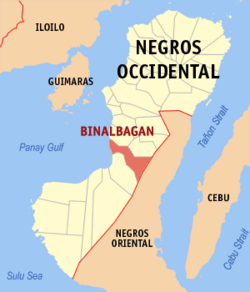Binalbagan | |
|---|---|
| Municipality of Binalbagan | |
 Binalbagan welcome marker | |
| Nicknames: The True Heart of Negros Banwang Panganay | |
 Map of Negros Occidental with Binalbagan highlighted | |
 Interactive map of Binalbagan | |
Location within the Philippines | |
| Coordinates: 10°12′N122°52′E / 10.2°N 122.87°E | |
| Country | Philippines |
| Region | Negros Island Region |
| Province | Negros Occidental |
| District | 5th district |
| Founded | May 15, 1572 |
| Barangays | 16 (see Barangays) |
| Government | |
| • Type | Sangguniang Bayan |
| • Mayor | Emmanuel I. Aranda |
| • Vice Mayor | Mary Ann T. Mirasol (UNegA) |
| • Representative | Emilio Bernardino L. Yulo III (Lakas) |
| • Municipal Council | Members |
| • Electorate | 45,508 voters (2025) |
| Area | |
• Total | 189.96 km2 (73.34 sq mi) |
| Elevation | 5.0 m (16.4 ft) |
| Highest elevation | 34 m (112 ft) |
| Lowest elevation | 0 m (0 ft) |
| Population (2024 census) [3] | |
• Total | 72,594 |
| • Density | 382.15/km2 (989.77/sq mi) |
| • Households | 17,305 |
| Economy | |
| • Income class | 1st municipal income class |
| • Poverty incidence | 23.64 |
| • Revenue | ₱ 365 million (2022) |
| • Assets | ₱ 780.7 million (2022) |
| • Expenditure | ₱ 291.2 million (2022) |
| • Liabilities | ₱ 272.2 million (2022) |
| Service provider | |
| • Electricity | Negros Occidental Electric Cooperative (NOCECO) |
| Time zone | UTC+8 (PST) |
| ZIP code | 6107 |
| PSGC | |
| IDD : area code | +63 (0)34 |
| Native languages | Hiligaynon Tagalog |
| Website | www |
Binalbagan, officially the Municipality of Binalbagan (Hiligaynon : Banwa sang Binalbagan; Tagalog : Bayan ng Binalbagan), is a municipality in the province of Negros Occidental, Philippines. According to the 2024 census, it has a population of 72,594 people. [5]
Contents
- History
- Geography
- Barangays
- Climate
- Demographics
- Languages
- Economy
- Education
- Notable personalities
- References
- External links
Major economic activities include manufacturing, agriculture, services, cottage industries and tourism. Binalbagan is also known for the Binalbagan Isabela Sugar Company (BISCOM).



